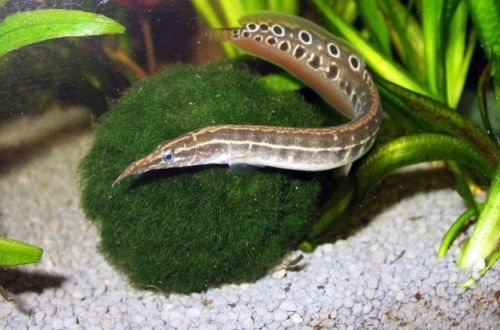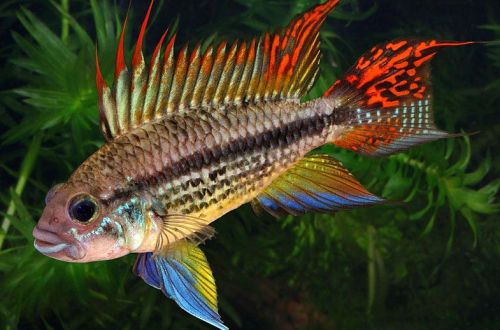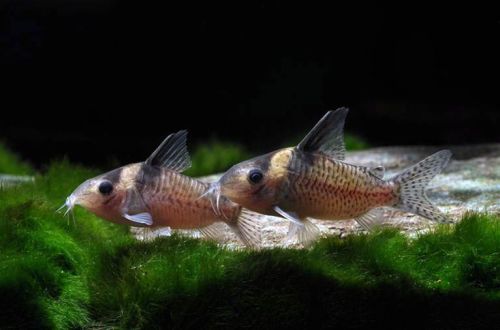
spiny eel
Macrognathus ocular or Prickly eel, scientific name Macrognathus aculeatus, belongs to the Mastacembelidae family. This species can become one of the most inconspicuous inhabitants of the aquarium due to its secretive lifestyle. It is a predator, but at the same time it has a peaceful disposition and is perfectly compatible with other fish of a suitable size. Fairly easy to maintain, able to adapt to various pH and dGH ranges.

Contents
Habitat
This species is widely distributed in Southeast Asia, the Middle East and Africa. They live in fresh and brackish waters. They prefer regions with a slow current and soft substrates, in which eels burrow in anticipation of passing prey.
Brief information:
- The volume of the aquarium – from 80 liters.
- Temperature – 23-26°C
- Value pH — 6.0–8.0
- Water hardness – soft to hard (6-35 dGH)
- Substrate type – sandy
- Lighting – subdued, moderate
- Brackish water – acceptable, at a concentration of 2-10 g per 1 liter of water
- Water movement – weak, moderate
- The size of the fish is about 36 cm.
- Nutrition – meat feed
- Temperament – conditionally peaceful
- Content single
Description
Adult individuals reach a length of up to 36 cm, but in an aquarium they rarely grow more than 20 cm. The fish has a long snake-like body and a pointed, elongated head. The pelvic fins are small and short. The dorsal and anal fins are located behind the body and stretch to a small tail, forming one large fin in place with it. The color varies from yellow to light brown, and vertical dark stripes may be present in the pattern. A characteristic feature is a thin light stripe that runs from the head to the very tail, and on the back of the body there are large black spots with a light border. The dorsal fin is equipped with sharp spikes, prickles, thanks to which the fish got its name – Prickly eel.
Food
In nature, it is an ambush predator feeding on small fish and crustaceans. In a home aquarium, they will accept fresh or frozen pieces of fish meat, shrimp, mollusks, as well as earthworms, bloodworms, etc. As a supplement to the diet, you can use dry food with a lot of protein that settles to the bottom, for example, flakes or granules.
Maintenance and care, arrangement of the aquarium
Ocellated macrognathus leads a not too mobile lifestyle, staying in one place for a long time, so an 80-liter aquarium will be enough for one fish. In the design, the substrate is of key importance, you should choose soft soils from coarse sand, which will not cake to a dense mass. The remaining elements of decor, including plants, are selected at the discretion of the aquarist.
Successful management of carnivorous, waste-producing species depends on maintaining high water quality. A productive filtration system is a must, along with a weekly replacement of part of the water (20-25% of the volume) with fresh water and regular cleaning of the aquarium.
Behavior and Compatibility
Juveniles may be in a group, but as they grow older, they show behavior characteristic of territorial species, therefore they are kept alone. Despite its predatory nature, the Spiny Eel is harmless to fish large enough to fit in its mouth. Gourami, Akara, Loaches, Chainmail catfish, peaceful American cichlids, etc. are suitable as neighbors.
Breeding / breeding
At the time of this writing, there are no successful cases of breeding Macrognathus ocelli in the home aquarium. In nature, spawning is stimulated by changes in habitat caused by the onset of the rainy season. Eels lay about 1000 eggs at the base of aquatic plants. The incubation period lasts 3 days, after which the fry begin to swim freely. Parental instincts are poorly developed, so adult fish often hunt for their own offspring.
Fish diseases
This species is sensitive to water quality. Deteriorating living conditions inevitably affect the health of fish, making them susceptible to various diseases. Read more about symptoms and treatments in the Aquarium Fish Diseases section.





